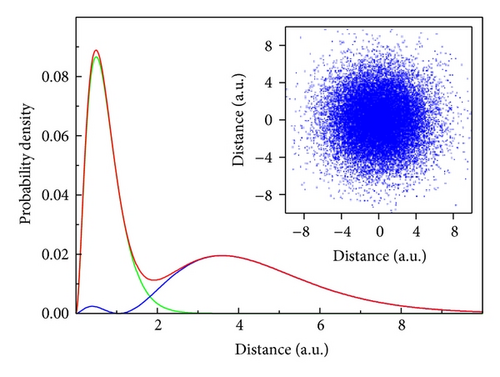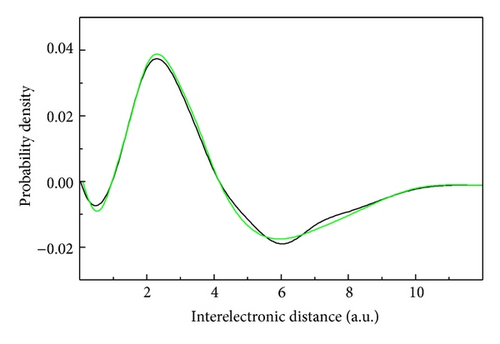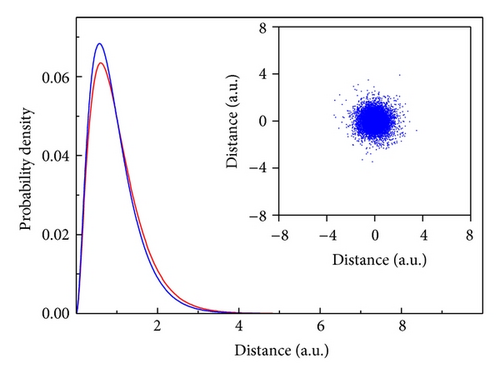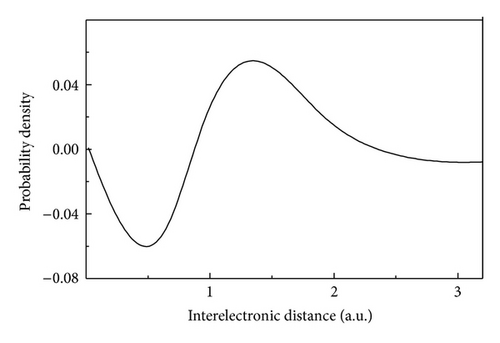Electron-Pair Densities with Time-Dependent Quantum Monte Carlo
Abstract
We use sets of de Broglie-Bohm trajectories to describe the quantum correlation effects which take place between the electrons in helium atom due to exchange and Coulomb interactions. A short-range screening of the Coulomb potential is used to modify the repulsion between the same spin electrons in physical space in order to comply with Pauli′s exclusion principle. By calculating the electron-pair density for orthohelium, we found that the shape of the exchange hole can be controlled uniquely by a simple screening parameter. For parahelium the interelectronic distance, hence the Coulomb hole, results from the combined action of the Coulomb repulsion and the nonlocal quantum correlations. In this way, a robust and self-interaction-free approach is presented to find both the ground state and the time evolution of nonrelativistic quantum systems.
1. Introduction
The importance of the electron-pair density, also known as electron position intracule, comes from the fact that it can be associated with experimental data obtained from X-ray scattering, and it can also be used to visualize the notion of exchange and correlation holes which surround the quantum particles. However, the calculation of the many-body wave function in (1) is hampered by the computational cost which scales exponentially with system dimensionality. Therefore, different approximations have been employed in order to calculate the electronic pair densities. These include Hartree-Fock (HF) approximation as well as Hylleraas type explicitly correlated wave functions represented as product of HF function and pair-correlation factors [3–6]. Other (e.g., quantum Monte Carlo [7]) approaches use appropriate Slater-Jastrow-type many-body wave functions which involve number of parameters, which after optimization can be used to calculate the average in (1).
Here we calculate the electron-pair densities for helium atom in 2 1S and 2 3S states using the recently proposed time-dependent quantum Monte Carlo (TDQMC) method which employs sets of particles and quantum waves to describe the ground state and the time evolution of many-electron systems [8–13]. In TDQMC each electron is described statistically as an ensemble of walkers which represent different replicas of that electron in position space, where each walker is guided by a separate time-dependent de Broglie-Bohm pilot wave. The correlated guiding waves obey a set of coupled time-dependent Schrödinger equations (TDSE), where the electron-electron interactions are accounted for using explicit nonlocal Coulomb potentials. In the TDQMC algorithm the preparation of the ground state of the quantum system involves a few steps which include initialization of the Monte Carlo (MC) ensembles of walkers and guide waves, followed by their concurrent propagation in complex time toward steady state in the presence of random component in walker’s motion to account for the processes of quantum drift and diffusion. Once the ground state is established, the real-time quantum dynamics can be studied, for example, the interaction of atoms and molecules with external electromagnetic fields. The large speedup of the calculations when using TDQMC comes from the fact that walker’s distribution reproduces the amplitude (or modulus square) of the many-body wave function, while its phase is being disregarded as it is not needed for most applications. Also, the TDQMC method can be implemented very efficiently on parallel computers where tens of thousands of coupled Schrödinger equations can be solved concurrently for affordable time.
2. General Theory
3. Exchange and Coulomb Correlations in Helium
The two major sources of electron-electron correlation are due to the symmetry of the quantum state and due to the Coulomb repulsion. Here we consider first the effect of the exchange correlation on the pair-density function of helium atom. Although the electron-pair densities for helium have been analyzed by different techniques, they have never, to the author’s knowledge, been studied using time-dependent methods.
In order to examine the electron correlation which is due to the exchange interaction, we consider the spin-triplet ground state of helium (orthohelium). The preparation of the ground state is described elsewhere [11, 12]. In the calculation here we use up to 100 000 Monte Carlo walkers and the same number of guiding waves, which are propagated over 2000 complex time steps (see (5) through (10)) in the presence of random component in walker’s motion such that each walker samples the distribution given by its own guiding wave. In order to determine the screening parameter of (9), we invoke the Hartree-Fock approximation, where for the Coulomb potential in (7) reduces to a simple (unweighted) sum of the Coulomb potentials due to all walkers. Because of the spherical symmetry of the 2 3S state is being varied until minimizing the mean integrated squared error of the walker’s distribution against the probability distribution obtained from an independent Hartree-Fock solution (e.g., in [15]). Figure 1 shows the probability distributions obtained from TDQMC for the optimizing value of a.u. in (9). The blue and the green lines show the densities of the walkers guided in physical space (see (5) through (9)), respectively, while the red line represents the radial distribution of the walkers guided in configuration space (see (10)). In these calculations a new accurate algorithm for kernel density estimation was used [16]. Notice that all probability distributions throughout this paper are normalized to unity.

The electron-pair density for the ground state was calculated very efficiently by simply performing kernel density estimation over the ensemble of distances between the primed walkers. The result is shown in Figure 2(a) where the blue and the red lines present the cases with and without exchange interaction, respectively. The lack of exchange ( in (9)) leads to a full (unscreened) Coulomb repulsion, which in the limit of infinite nonlocal correlation length () becomes equivalent to the Hartree approximation. Figure 2(b) shows the difference between the two curves in Figure 2(a), which in fact depicts the shape of the exchange hole for the 2 3S state of helium (see also e.g., [5]). Note that the exchange hole in our calculation may differ from other results because the distribution of the Monte Carlo walkers varies in radial direction as r2R2(r) instead of as R2(r), where R(r) is the radial wave function. The green line in Figure 2(b) shows the exchange hole obtained from an independent Hartree-Fock calculation with no potential screening. It is seen that the two curves are close where the deviations for larger interelectronic distances are mainly due to the fast decrease of the walker’s density away from the core. As the screening parameter tends to zero both the height and the width of the exchange hole decrease until the two curves in Figure 2(b) become very close, with the only remaining difference being a result of purely Coulomb correlations.


For the ground state of the 2 1S (para)helium, the quantity of interest is the Coulomb hole which occurs due to the repulsion of the closely spaced walkers. Figure 3 shows the probability distribution of the ground state walkers as compared to the Hartree-Fock calculation, while Figure 4(a) depicts the corresponding interelectronic distances for the two cases. The Coulomb hole calculated as the difference between the two curves is presented in Figure 4(b) which is close to previous results by other methods [3]. As the nonlocal correlation length tends to infinity, both the height and the width of the Coulomb hole decrease until the two curves in Figure 4(b) coincide. Thus, in our approach where the exchange and the Coulomb correlations are accounted for by solely modifying the potential of electron-electron interaction in physical space, the two parameters and may ensure a smooth transition between the Hartree, the Hartree-Fock, and the fully correlated approximations to the electron-electron interaction. It is important to point out that in the ℏ/m → 0 limit the quantum drift in (6) vanishes and so does the width of the quantum wave packet. Therefore, for an isolated atom the quantum correlation length tends to zero in this limit, and if there are no exchange effects (), the ensemble of quantum particles governed by (5) and (6) transforms to an ensemble of classical particles with the only force being due to the standard Coulomb repulsion between these particles.



4. Conclusions
In this paper, it has been shown that for charged particles, the quantum correlation effects which occur due to the exchange and Coulomb correlations can adequately be described by sets of de Broglie-Bohm walkers within the time-dependent quantum Monte Carlo framework. A short-range screening of the Coulomb potential ensures that each replica of a given electron interacts with only those replicas of the rest of the same spin electrons which are sufficiently apart to respect Pauli’s exclusion principle in space. On the other hand, the electron-electron interaction is modified by the quantum nonlocality which demands that each replica of a given electron interacts with the replicas of the other electrons which are within the range of the nonlocal quantum correlation length. This concept allows one to build a robust, self-consistent, and self-interaction-free approach to find both the ground state and the time evolution of quantum systems. It is demonstrated here that the otherwise awkward procedure for calculating the pair distribution functions of para- and orthohelium atom can be simplified to the level of finding the ground state probability distributions of the corresponding Monte Carlo walkers.
Besides the relative ease of its implementation, another advantage of using TDQMC is the affordable time scaling it offers which is almost linear with the system dimensionality. This is especially valid when using multicore parallel computers where little communication overhead between the different processes can be achieved, thus utilizing the inherent parallelism of the Monte Carlo methods. This nears the TDQMC to other efficient procedures for treating many-body quantum dynamics such as the time-dependent density functional approximation which, however, suffers systematic self-interaction problems due to the semiempirical character of the exchange-correlation potentials.
Acknowledgments
The author gratefully acknowledges support from the National Science Fund of Bulgaria under Grant DCVP 02/1 (SuperCA++). Computational resources from the National Supercomputer Center (Sofia) are gratefully appreciated.




